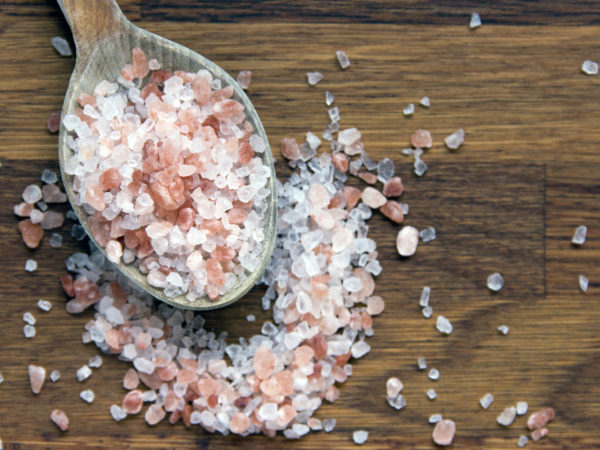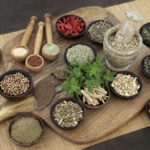Cooking With Spices: Salt

Salt is a mineral that has been used worldwide since antiquity as a flavoring, preservative, medicine and sacred offering. It is composed mainly of sodium chloride (NaCl), which is part of the class of ionic salts. In its natural form, salt is called rock salt or halite. In its edible form, it can be purchased as sea, table, kosher and iodized salt.
Salt has been concentrated and isolated for human and animal use for thousands of years. One of the largest sources is seawater – its salinity is about 3.5 percent. Salt from ancient seabeds is also mined for consumption. China, Pakistan, the U.S., Germany, Canada and India lead the world in supplying salt. An estimated two hundred million tons are produced annually, and about six percent of that is food grade. The rest is used for purposes such as conditioning (“softening”) household water and de-icing roads.
Salt is so necessary that governments sometimes levy heavy taxes on it, assuming that citizens will have no choice but to pay. It does not always work out that way: France had an oppressive salt tax that led, in part, to the French Revolution, and Mahatma Gandhi in 1930 encouraged 10,000 protesters to defy British salt taxes by making their own salt.
Its religious and cultural significance has a long history. Ancient Greeks, Romans and Egyptians offered salt and water to their gods – possibly a precursor to the modern Catholic convention of holy water. It is used in religious ceremonies including housewarmings and weddings, is thought by Buddhists to ward off evil spirits, and various religions use salt as a purification tool to cleanse people and places of negative energies.
One reason salt has been so prized is that it has been the most available and useful food preservative for thousands of years, especially for meat. As a result, as civilization spread, salt became one of the world’s main trading commodities.
Sodium is vital for health. It makes up 40 percent of table salt by weight, and helps regulate water balance, control muscle and nerve function, and keep the circulatory system functioning properly. Humans require sodium to regulate blood pressure and protect against blood clotting. It also plays a role in digestive function, helping to metabolize food, and in balancing blood sugar.
Salt has other medicinal applications: topically, it can be used in a bath to relieve dry, itchy skin, making it a good choice for people with eczema and psoriasis. Traditionally, asthmatics have sprinkled sea salt on the tongue after drinking water, in the belief that it may help reduce inflammation in the respiratory system. There is no evidence to support the efficacy of this practice, however.
Low blood sodium, known as hyponatremia, can be caused by health conditions such as liver or kidney failure, or by drinking too much water too quickly, which lowers sodium concentration in the bloodstream. Excessive perspiration can cause the condition as well, which leads to symptoms including nausea, vomiting, headache, confusion, and if severe, coma and death if untreated. Hyponatremia is seldom caused simply by low sodium intake – nearly all common foods contain some sodium, and the body can habituate to extremely low dietary sodium levels over time.
Rather than low sodium, a far more common modern problem is excessive intake. Salt is the main source of sodium in our diet. Although adults need only about 1.5 to two grams of sodium per day, the average American intake is five to six grams. Sodium content is high in processed foods such as snack foods, fast food, canned and frozen foods, lunchmeats, and some condiments and foods that are pickled. Excess dietary sodium has been linked to a variety of health issues, ranging from fluid retention and circulatory problems to high blood pressure, heart, or kidney disease. People at risk for these problems may benefit from a low-sodium diet.
Dr. Weil’s take on salt:
I consume almost no processed food and sprinkle salt on my cooked food sparingly. I do not avoid it altogether, and feel that abstemious low-salt diets have little to offer most healthy people. Added salt imparts essential flavor to vegetables, soups, stews and fish – food quickly becomes much less interesting with no added salt.
It’s important to realize, however, that salty flavor can be imparted in other ways. I often use high-quality soy sauce in cooking. A tablespoon of soy sauce contains about 900 mg of sodium, while a tablespoon of salt has 7,000 mg. That means on a per-volume basis, soy sauce is far and away the better choice – and I think it often tastes better as well.
Similarly, when cheese is added to a salad or cooked dish, added salt usually becomes unnecessary, as the cheese itself is salty.
I am a great fan of exotic salts, and enjoy experimenting with pink or gray varieties. These not only offer unusual flavors, but in many cases are lower in sodium and have higher concentrations of other essential, hard-to-obtain minerals such as magnesium.
More information on salt:










